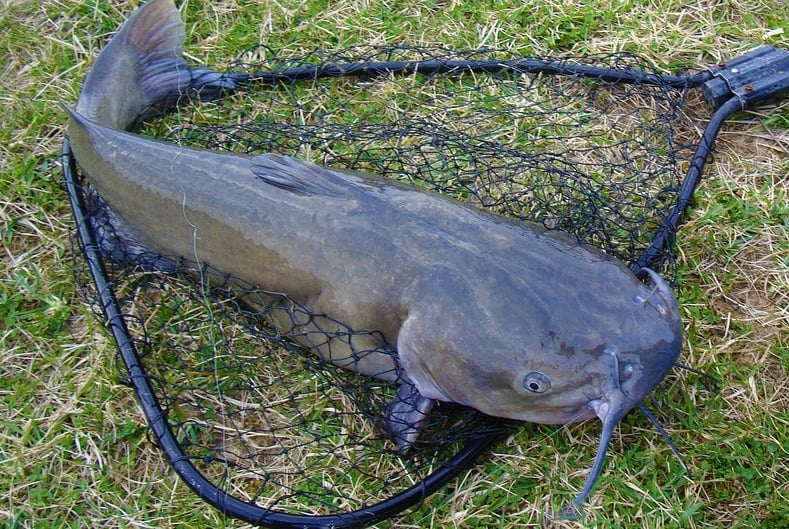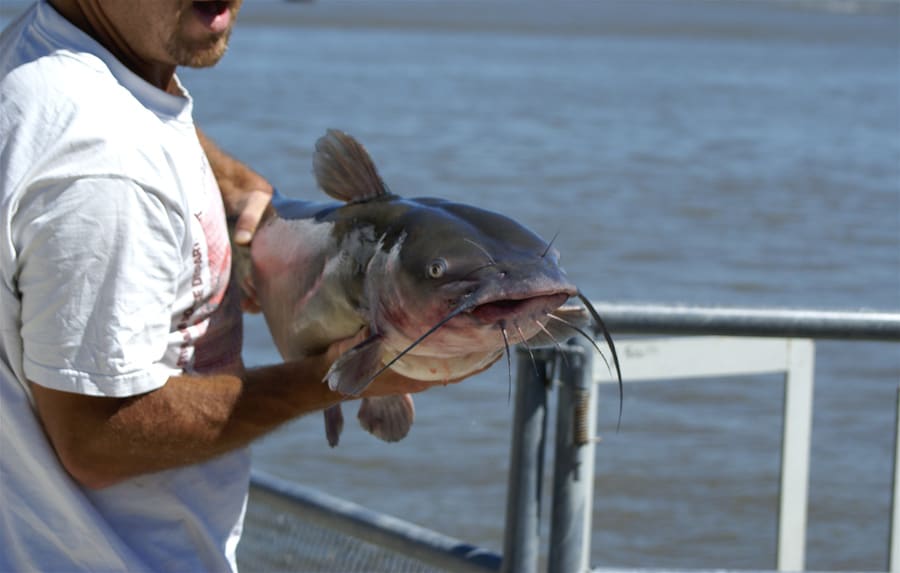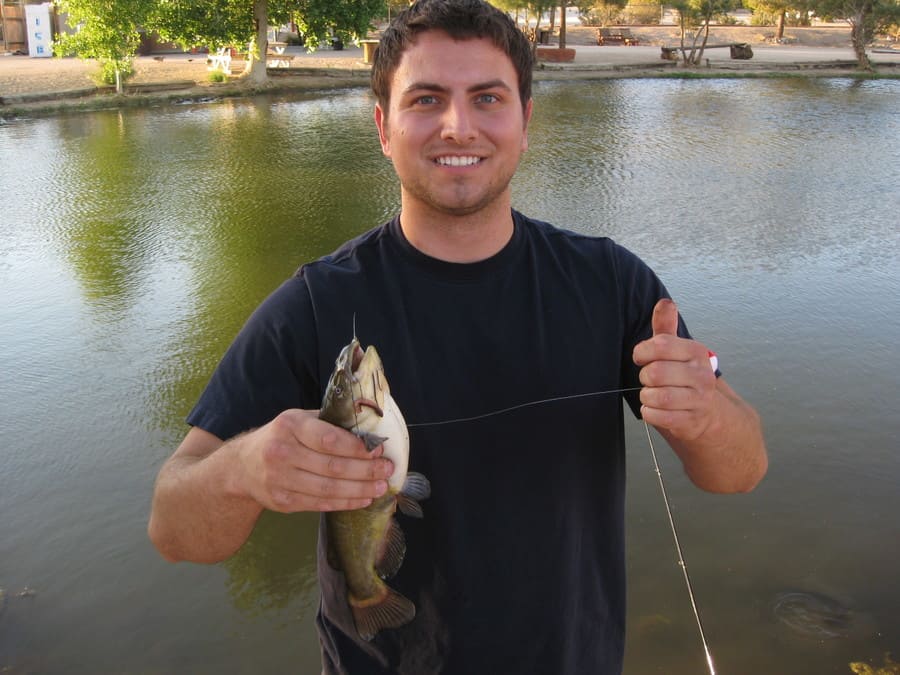Bluegills as Catfish Bait (How-to, Rigging Bluegills, Tips)

Leave a comment after this article and let’s talk more about catfishing. I’d love to read your feedback.
Fishermen often wonder if bluegills make good catfish bait. After all, bluegills are plentiful in most catfish waterways so it’s a natural question to ask yourself.
Can you catch catfish using bluegills as bait? Catfish love eating bluegills and in waterways where it is legal to use bluegills as bait, you can catch more and larger catfish using live or cut bluegills than almost any other bait.
There many considerations to take when it comes to the capture, selection, and rigging of bluegills for catfish angling which will be covered in this article.
Catfish love eating baitfish and bluegills represent a large part of most catfish diets in many rivers and reservoir systems. Bluegills are plentiful, have great nutritional value to big catfish, and can be easy to catch.
Bluegills are a natural food source for flathead, channel, and blue catfish and can even be a food source to very large bullheads as well.
Catfish will readily feed on bluegills all year long but the bite seems to be best in the summer and winter seasons. In this article, we will cover how to catch bluegills, which size bluegills you should select, how to rig them, and how to catch catfish using bluegills as bait.
One of my favorite overall baits for big catfish are bluegills, both whole and cut. For big flathead, I think a whole medium-sized bluegill is a perfect bait. I have caught flathead over 30 pounds using big bluegills as bait. For smaller flathead along with big blue and channel catfish, bluegills cut in half are the best choices. I caught a really nice 45-pound blue catfish on the James River using half of a large bluegill 2 years ago.
For a complete gear and tackle recommendation for catfish, check out my recommended catfish gear list which will help you catch more and larger catfish than anyone else.
Why are Bluegills Good Catfish Bait
Bluegills, and really any panfish, make great catfish baits for a variety of reasons to include size, being a natural food source, availability, and hardiness. Let’s break each of these reasons down.
Size
Bluegills are small, hand-shaped fish that are naturally a perfect size for the powerful crushing jaws of catfish. Catfish will consume baitfish they can comfortably fit inside their mouths.
While catfish will not eat very large bluegills, almost any bluegill smaller than 7 inches in length can be consumed by at least the biggest of flathead catfish. The ideal bluegill size would be 4-5 inches which would suit blue catfish, channel cats, and flathead catfish well.
Natural Prey
There are hundreds of stinkbaits, gels, concoctions, and witchcraft on the market designed to catch catfish. While many of these baits can catch catfish, there’s no better way to catch more or bigger catfish than with natural bait. Find out which what catfish in your lake or river are feeding on and give them it.
Whether it is baitfish, clams, crayfish, shrimp, or algae. Baitfish, in particular, are deadly on catfish and bluegills are in the upper echelon of natural catfish bait, especially for blue and flathead catfish.
Availability
There are perhaps no more widely distributed freshwater fish, at least in the United States, as bluegills. Bluegills are excellent bass and catfish food, fight hard, are easy to catch, and breed rapidly making them ideal fish to stock in just about every lake, pond, reservoir, and even rivers.
Because they are found just about everywhere, almost all catfish seem to have access to bluegills. This high availability-rate coupled with their nutritional value makes them an excellent catfish bait.
Hardiness
Bluegills are one of the hardiest catfish baits around. They can tolerate less-than-ideal water conditions and oxygen-levels that would do-in more sensitive species shad, minnows, and trout.
They also will stay alive better during the summer months than shad making them the perfect summer-time catfish bait.
Unlike shad which will die right after netting or shortly after being rigged, bluegills will survive a lot better and remain alive throughout the whole process as long as you only cast it once or twice.
For a complete gear and tackle recommendation for catfish, check out my recommended catfish gear list which will help you catch more and larger catfish than anyone else.
How to Catch Catfish Using Bluegills as Bait
Catching the Right Size Bluegills
It is important to catch bluegills the right size for catfish angling. You will want to match the size of the catfish’s mouth with the size of the bait. Flathead catfish can consume larger bait than channel catfish and even blue catfish since their mouths are bigger.
This is why big flathead catfish require large live bait whereas you can catch plenty of big channel and blue catfish on smaller live bait as well as cut bait pieces of shad and bluegills. For most blue catfish and especially channel cats, select smaller bluegills as bait.
If you want to have a fun few hours of catfish fishing, you’ll need at least 10 healthy bluegills as bait. There are a variety of methods you could use to obtain your bait. If trapping is permitted in your local waters, cloverleaf traps can be an excellent tool for catching all sizes of bluegills.
Minnows traps can catch you a lot of very small bluegills but the tiny openings won’t allow bluegills more than 2 inches long to enter.
Casting nets work really well for catching bluegills but you need to be careful. Casting nets have a tendency of being shredded by snags and debris which is exactly where bluegills like to congregate. Instead, focus throwing casting nets at bluegills in areas free of snags such as docks and alongside boats.
For most people, the practical way to catch bluegills will be by catching them on hook-and-line. Bluegills are easily caught on small pieces of worms, mealworms, grasshoppers, small minnows, corn, and pieces of Slim Jims.
When you start casting into a school of bluegills, it usually happens that the biggest, most aggressive bluegills attack your bait first.
As you catch more and more, you’ll notice the size of your catch keeps shrinking. If you are only after larger bluegills, don’t keep fishing in a spot once the size of bluegill starts to shrink. Instead, find a new school of bluegills and keep moving around until you get your fill.
To keep your bluegills alive and healthy, a well-aerated live well or bucket bait container with holes can be great. You could also use collapsible laundry baskets too which are cheap and provide great ventilation for your bluegills to remain lively.

Required Gear/Tackle for Catfish Using Bluegills
When catching bluegills to use as catfish bait, you don’t need much. An ultralight spinning rod, 4-pound test mono, and a size 14 fish hook is about it. A small bobber can help as well.
When it comes to tackling catfish, however, you’ll need some legit equipment. You could go with either spinning or baitcasting gear but you’ll want a medium-action rod with a good backbone for power.
You’ll need at least 15-pound test line with dealing with big catfish. I recommend either mono or braided fishing line. They both serve their roles. Many serious catfishermen don’t use anything less than 40-pound braid but I think that may be a little much for most catfish.
As far as terminal tackle is concerned, hooks and sinkers are what we need. You will want a good-quality fishing hook that is strong, flexible, and very sharp. You could use a bait hook or octopus hook, but I feel for catfish using bluegills as bait, you really should go with a circle hook.
I’d recommend a size 1/0 through 5/0 circle hook. You’ll also need a 2-3 ounce lead weight to keep your live or dead bluegill near the bottom and provide a little tension to begin setting the circle hook after the fish bites.
How to Use Live Bluegills as Catfish Bait
Using live bluegills is the best way to target trophy flathead catfish. These monsters prefer their bait whole and alive. Channel catfish and blue catfish will also eat living bluegills but they have smaller mouthparts and simply prefer dead cut bait over living bluegills.
To fish with whole live bluegills, you have two ways to rig it. In water without current, run your circle hook through the back behind the dorsal fin.
To rig bluegill for moving water, hook the bluegill through the nose with the hook point oriented upwards. This will make the fish more aerodynamic and reduce snags from moving debris.
How to Use Dead Bluegills as Catfish Bait
Sometimes bluegills die. Sometimes the situation of target species requires half a bluegill instead. At any rate, let’s teach you how to use dead bluegills as bait.
Whole
To fish with whole dead bluegill, you have two ways to rig it. In water without current, run your circle hook through the back behind the dorsal fin. To rig dead bluegill in moving water, hook the bluegill through the nose with the hook point oriented upwards. This will make the fish more aerodynamic and reduce snags from moving debris.
This is by far the best way to catch big flatheads with dead bluegills as they prefer whole bait. Living bluegills will work better for big flatheads but whole dead bluegills is a close second.
Cut
My favorite way to fish catfish with dead bluegills is by cutting the bluegills in half. You can use the head and the back sections each as bait. This is optional but I like to cut off the tail as well since this will give smaller catfish something to latch onto so they can tear your bait off the hook.
I simply just cut my tails off. This is the best method for blue catfish and channel cats who prefer their baits in pieces.
Cured
Another great way to fish with dead bluegills and really any dead baitfish is to cure them. The beauty of curing your baitfish is it helps preserve the meat, makes the meat tougher and less likely to breakdown on the hook, and add some great flavor and scent to the bait. There are plenty of cures on the market and they all seem to do the trick.
You could also add some curing dye to the mixture to include some color which could help big fish find your bait. Once you’ve cured your bluegills, you could freeze them or use them fresh. You could also fish with them whole or cut them up in pieces.
Use Bells to Indicate Bites
I can’t stress this one enough. I recommend highly that you attach bells or some type of electronic strike indicating system on your rod tip or rod. You don’t need a bell to tell when you have a catfish on the line. What you do need bells for, however, is to tell you when you are getting bit.
Catfish are notorious for grabbing baitfish and tearing them off the hook. It is very important you know exactly when you are getting a bite. If you get a bite and then nothing for 5 minutes, chances are very strong you have no bait on your hook.
Without a bell on your rod, you never would’ve known you were fishing without bait and you could have wasted an hour or more with no chance for success. Instead, the bell will tell you immediately when something is messing with your bait. If the rod goes silent for a few minutes, you can bet you need to add more bait.
This is especially the case when using bluegills as bait. Even small catfish love attacking and eating bluegills. Small catfish will grab and tear at your bluegill and you’ll be left fishing with a bare hook. Buy some bells at your bait shop. They are very cheap.
Each Catfish Species: Best Bluegill Size
Flathead Catfish: Whole living bluegills 4-8 inches long. Dead whole bluegills work well too.
Channel Catfish: 5-8 inch bluegill cut in halves are best. Smaller living bluegills work too.
Blue Catfish: 6-9 inch bluegill cut in halves are best. Living bluegills, 3-4 inches long well too especially in the winter.
Bullhead Catfish: small live bluegills under 3 inches in length of small cut pieces of bluegills work.

If you want to learn how to catch a lot of catfish in the winter, a season everyone wrongly thinks is off-limits for good catfishing, you need to read the how-to article I wrote on the topic.
How About Other Panfish as Catfish Bait?
Bluegills are not the only panfish that work for catfish. Catfish routinely consume warmouth, crappie, rock bass, white perch, pumpkinseed, green sunfish, and many others. Bluegills are simply preferred by both catfish and anglers alike.
Bluegills are the easiest to catch and they are actively stocked in much more waterways than any other panfish. Any of the above-listed panfish will catch large catfish. It just seems that big catfish, especially big flatheads, really prefer bluegills over all other panfish.
Oddly enough, small carp and small bullheads make great bug catfish bait too. Catfish are generalist omnivores meaning they’ll eat plants and meat.
As catfish get bigger and older, their diet becomes more than 80% fish and bluegills and shad simply are the preferred meals for most big cats.
Summertime Considerations
Bluegills work great for channel, flathead, and blue catfish all year long but they really excel in summer. I generally categorize bluegills and shad as the two best catfish baits above all others. Well, the downside to shad is they die really easy.
They stress very easily and don’t survive well after being caught in a net. If you have any intent of fishing with shad during the summer, you’ll almost always have to fish with dead shad. Shad are also extremely hard to catch if you don’t have access to a boat, sonar, and a casting net. They are simply out of the equation for bank fishermen.
The beauty of bluegills is that they are very resilient little fish. Bluegills are very tolerant of poor water qualities and can handle warmer, less oxygenated water pretty well. Much better at least than fragile shad can.
Bluegills also cope with stress a lot better. You can catch large catfish all year long, but during the summer especially, there is simply no better catfish bait than bluegills. Other panfish like pumpkinseed, yellow perch, warmouth, and green sunfish work great too as long as your state permits their use as live or dead bait.
Legality of Using Bluegills as Bait
This section is one of the most important in this entire article. Also, consult with your state and local fishing regulations regarding the use of baitfish and, in particular, bluegills as fishing bait.
For example, in California where I’m currently residing, bluegills are currently illegal to use as bait in most waterways within the state. In fact, we are not even allowed to possess a live bluegill in a pale-full of water, let alone catch 20 to use as live bait. Bluegills we kill must not be used as bait, only to be kept for human consumption.
Check with your state’s fishing regulation to find out your rights and privileges. If you are ever unsure of the law, as often the legal jargon in fishing regulations can be confusing, feel free to contact your local game warden for clarification.
I want you to catch a lot of catfish but I don’t want you to do something illegal in the process which could result in fines and even a suspended fishing license.
How Do Bluegills Compare to Other Catfish Bait
Simply put, catfish love natural bait. Yes, there are countless gimmicky catfish baits on the market, with varying degrees of smelliness.
And truth be told, many of these baits are effective for small and medium catfish. But if you want to catch large catfish, your best option is natural bait.
This doesn’t necessarily mean only baitfish. If catfish in your lake are feeding mostly on clams or crayfish, use them. However, in the majority of lakes, the main food source for large catfish (blues, channels, and flatheads) will be fish.
Catfish love eating fish. Catfish will devour just about any fish species it can get its mouth around. Very common food items for large catfish include suckers, bluegills, carp, trout, shad, minnows, shiners, perch, panfish, and eels.
Compared to the rest, bluegills are right up there with shad as the best big catfish baits. I am completely making this stat up, but 9/10, live or cut bluegill will outperform even the best artificial catfish bait for trophy catfish.
At least that is my experience and the experiences of most serious catfishermen. There’s a reason why all the professionals use only fresh-caught bait in catfish tournaments.
If you are still hungry for more great information about fishing for catfish, you can’t skip these 2 great resources I wrote that will make you an even better catfisherman than you are.
These are jam-packed with useful information. If you are interested in catching catfish using worms, you need to read this post. Dispell all the rumors and learn the art of catching catfish with this article asking “Are Catfish Hard to Catch?” Hint: the answer is ‘not if you know what you’re doing’.
